Raging Bull Blu-ray Movie
HomeRaging Bull Blu-ray Movie 
Metro-Goldwyn-Mayer | 1980 | 129 min | Rated R | Feb 10, 2009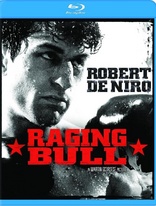
Movie rating
8.5 | / 10 |
Blu-ray rating
| Users | 4.5 | |
| Reviewer | 5.0 | |
| Overall | 4.5 |
Overview
Raging Bull (1980)
The story of Jake LaMotta, a former middleweight boxing champion, whose reputation for tenacity and success in the ring was offset by his troubled domestic life: full of rage, jealousy, and suspicion—particularly towards his wife and manager/brother—which, in the end, left him destitute, alone, and seeking redemption.
Starring: Robert De Niro, Cathy Moriarty, Joe Pesci, Frank Vincent, Nicholas ColasantoDirector: Martin Scorsese
| Drama | Uncertain |
| Biography | Uncertain |
| Sport | Uncertain |
Specifications
Video
Video codec: MPEG-4 AVC
Video resolution: 1080p
Aspect ratio: 1.85:1
Original aspect ratio: 1.85:1
Audio
English: DTS-HD Master Audio 5.1 (48kHz, 24-bit)
English: Dolby Digital 2.0
French: DTS 5.1 (48kHz, 16-bit)
Spanish: Dolby Digital 5.1
Portuguese: Dolby Digital 5.1
Turkish: Dolby Digital 5.1
Subtitles
English, English SDH, French, Portuguese, Spanish, Cantonese, Korean, Mandarin (Traditional), Thai
Discs
50GB Blu-ray Disc
Single disc (1 BD)
Playback
Region free
Review
Rating summary
| Movie | 5.0 | |
| Video | 4.5 | |
| Audio | 4.0 | |
| Extras | 4.5 | |
| Overall | 5.0 |
Raging Bull Blu-ray Movie Review
The De Niro/Scorsese classic proves itself a winner by technical knockout in its 1080p debut.
Reviewed by Greg Maltz February 11, 2009If there is any actor-director tandem better than Robert de Niro and Martin Scorsese, I haven't seen it. And if there is a better release of Raging Bull than MGM's new Blu-ray edition, I haven't seen that either. The BD is a must-buy with impeccable picture and sound quality. For those unfamiliar with Raging Bull, De Niro and Scorsese are at the height of their creative powers, delivering a black-and-white tour-de-force that to this day is their most focused and stark. Former middleweight champion Jake "The Bronx Bull" La Motta's rise and fall is depicted with rawness and analytical power.
The unflinching portrayal of La Motta's public life in the ring and his private life shows how his entire existence is an intense struggle for domination on his terms--no matter who is hurt in the process. Ultimately, the fighter's egocentrism and pride doom him to a real and metaphysical realm of sin and failure--whether he is in the ring or the street, at home or in a nightclub--pummeling his boxing opponent or his own brother or ultimately the concrete walls of a jail cell. The way Scorsese attacks the story, all of La Motta's fighting is relegated to a spiritual stage that relates to the canvas, to La Motta's ordeal later in his life and even beyond--to the sets of the film and the screens in our home theaters, and perhaps even the inner struggles of each of us. It is the director's ability to cinematically elevate the violence of the boxing ring and the sins of La Motta onto a spiritual plane that makes Raging Bull a masterpiece.
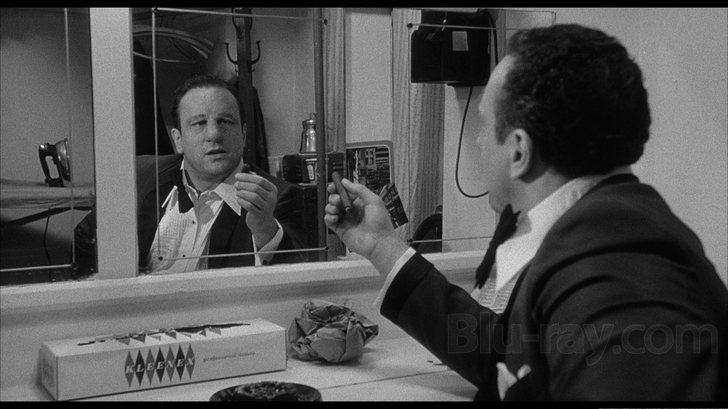
Whether his stage is the boxing ring or the dressing room of a seedy comedy club, Jake La Motta (Robert De Niro) proves to be his own worst opponent.
Tying back to the double- or triple-entendre of the "stage", Raging Bull opens with a stocky, middle aged La Motta--retired from boxing--in a nightclub dressing room, rehearsing one of his comedy routines. "Though I'm no Olivier, if he fought Sugar Ray he would say that the thing ain't the ring, it's the play. So give me a stage where this bull here can rage. And though I could fight, I'd much rather recite, 'that's entertainment'." That is essentially the thesis for the film--and what a powerful 129 minutes of entertainment it is! After La Motta's opening soliloquy, the film quickly starts back at the beginning of his career, when he seemed to fight with equal intensity against overwhelmed opponents in the boxing ring and against his first wife in his Bronx apartment.
Much has been written about De Niro's Oscar-winning performance. Beyond his method acting approach to the character, the physical transformation he underwent is almost beyond belief. His dedication to the role inspired him to add 70 pounds to his previously slim frame, allowing him to command with equal conviction his performance as a disciplined boxing champ and as a washed-up, overweight comedy personality. To prepare for the film, De Niro worked out with the real-life La Motta for an entire year, between April 1978 and April 1979, at the Gramercy Gym on East 14th Street, New York City. Even De Niro's face appears transformed for the role, with gauze stuck up his nose to make it fatter. Combined with his chameleon-like ability to adapt personality and traits in subtle and not-so-subtle ways, the overall effect is extraordinary. At times, it is difficult to watch, as much because of the physical transformation as the emotional lows, shown in unflinching detail, where La Motta descends. De Niro also had a strong supporting cast. Joe Pesci, in his first major role, plays La Motta's brother and manager, Joey--actually a composite of Jake's brother and a real-life friend, Pete Petrella. Pesci is rumored to have suffered a broken rib during a sparring scene with De Niro.
As for La Motta, he his credited as "consultant" for the film and the way he is portrayed, his psychology is complex. He wants the championship--but only on his own terms at a time when boxing was controlled at nearly every level by the mafia. In La Motta's day, if a boxer didn't have a manager hooked in to the mob bosses, his career would go nowhere. La Motta's insistance on staying aloof from the bosses and the wiseguys at the Copacabana not only cost him untold wealth and big-purse fights, it put an enormous strain on Joey, who was often forced to choose loyalty to his brother over his own well-being and the powerful figures in the community. Eventually, La Motta had to cave to the mafia and throw fights for a chance at the championship. But even when he had to lose, La Motta refused to go down--and kept that kernel as his only source of self-worth throughout his life. La Motta not only viewed mafia figures with distrust--though not shown in the movie, he ratted them out in a congressional hearing on fight-fixing--he also seemed to view women with disdain after they had been with him or anyone else. His emotional immaturity drew him to young girls. He divorced his first wife and started a relationship with 15 year old Vickie (Cathy Moriarty), eventually pushing her away and being arrested for illegal relations with a 14 year old girl. The narrative and psychological dynamics play to perfection in the way Scorsese and De Niro sketch out La Motta's relationships, his fighting style and every element of his personality.
The fight scenes themselves are choreographed in extraordinary detail, and took nine weeks to film. The rest of the movie took about 10 weeks. These scenes may not capture the essence of the "sweet science" as realistically as newer movies with bigger budgets, such as Cinderella Man. That wasn't Scorsese's goal so much as creating a more artistic, impressionist feel to boxing that would leave viewers with a distinct impression of each fight. The director calls for the size of the ring to be increased as the film progresses and the make-up and effects crew use fluidics to simulate the appearance of cuts opening and blood gushing. At one point, the camera pans away from the fighters and Scorsese shows blood dripping on the ropes after the most viscious fighting sequence--Sugar Ray Robinson's "Valentine's Day Massacre" to take the middleweight championship away from La Motta. There are many ways in which Scorsese deviates from a strict account of boxing to accommodate his vision and impression of each fight.
Raging Bull Blu-ray Movie, Video Quality 
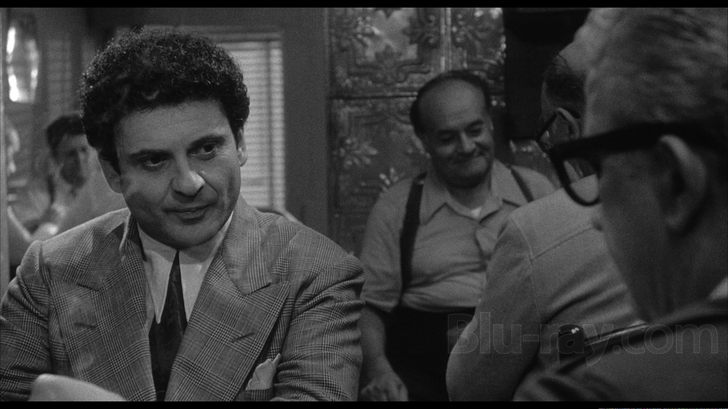
For years, many have debated why Scorsese shot Raging Bull in black and white. As he explains in the bonus content, when first screening the 8-mm test footage of De Niro sparring in a ring, the director did not like the image. At first, he was unable to figure out why. Michael Powell, an older director who had become a mentor and good friend to Scorsese in the 1970s, suggested that the color of the gloves was throwing off the picture, drawing attention away from the fighters' faces and creating imbalance. The rest is history. Raging Bull is the third black-and-white Blu-ray I've reviewed (after Casablanca and Persepolis) and its AVC encode at 28 mbps is the most film-like of the three. The larger bits of noise, such as dust specs have been meticulously removed, but a consistent sheen of film grain--most notably in light areas of the image--is visible throughout. Some telltale signs of digital cleanup are apparent but they are not obtrusive. Overall, the picture packs a powerful punch. It is by far the best edition of Raging Bull to hit home video.
The definition is not the wow-factor, although it offers many details that were previously lacking. The picture can best be described as organic with vibrant gradients from bright to dark and a lush analog quality as opposed to harsh or digital. Watch La Motta's fight taking place in Florida early in the film. Scorsese and director of photography Michael Chapman literally bend the light of the scene. The visuals seem supernatural and impressionistic, like waves of heat wafting up from asphalt or a bar-b-q. In 1080p, the effect is extraordinary. More conventional images like facial expressions, upholstery and clothing patterns appear well defined, if a touch soft. Often Scorsese opts for a noirish quality as a throwback to an earlier era of cinematography. Watch the scene where Vickie convinces Jack to phone Joey in the arena hallway after a victory. The low lighting and dark backdrop set the mood of the scene. Another classic from the same era that I recently reviewed, Gandhi showed gentle strobing throughout, as did The Pink Panther, from 1964, but Raging Bull cleans up more evenly, with no signs of flickering.
Raging Bull Blu-ray Movie, Audio Quality 
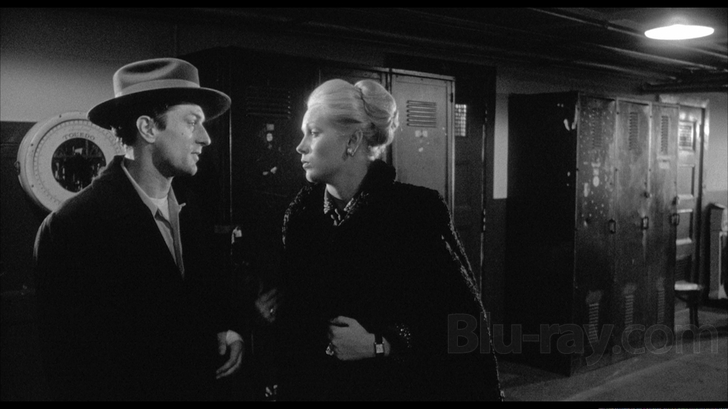
The first thing you will notice about the DTS-HD Master Audio 5.1 is that MGM mastered it for Blu-ray at a very low level. The center channel is especially receeded, but once the volume is brought to an appropriate level and the center level is increased relative to the other channels, the audio track shines. Orchestral score, dialog and sound effects are nearly as commanding as the video excellence. Raging Bull is the first Scorsese film that made use of his trademark frenzy of flashing bulbs of the cameras, and freeze-frame of the glow generated by the flash. While it makes for an interesting visual effect, the audio has far greater impact. Each pop of the vintage camera light bulbs yields a succinct blast, as if the photos and public eye is physically hitting La Motta. The sound is of a much higher frequency than the actual boxing blows, but the overall impression of the popping bulbs is not unlike La Motta being hit by a fist. A more general note: the 5.1 mix is heavily anchored up front with little or no content assigned to the surrounds, which is the proper way to mix the track.
While dialog sounds crisp and the actors' timbres are meaty with good presence, the music steals the show--particularly in classic shots like the Copacabana scene where Jake follows Vickie out of the night club with Gene Krupa's Drum Boogie setting the mood. Always immensely conscious of the music track, Scorsese chose segments of more than 30 musical pieces to deliver the color that was absent from the black-and-white film. Mascagni's Intermezzos are the brilliant glue that seems to hold it all together, featured during the opening and closing credits, color sequences meant to mimic home movies and stills showing fight scenes. Through all of this, the liquid midrange is dominant, with treble and bass a bit shelved.
Raging Bull Blu-ray Movie, Special Features and Extras 

Most of the supplementary content comes from the DVD version, repacked on Blu-ray in MPEG-2 with Dolby Digital. While new production is lacking, the quality and quantity of the previously produced featurettes is impressive, delivering a trove of trivia and a cornucopia of content that is simply too much information to address here in any comprehensive way. Much of it is essential viewing/listening for fans of the film and the principals involved.
The audio commentary is divided into three parts. Part one features Scorsese and editor Thelma Schoonmaker. Part two features producers Irwin Winkler and Robert Chartoff, cinematographer Michael Chapman, longtime Scorsese friend Robbie Robertson, as well as John Turturro who appears for the first time in a major picture as part of Sal's crew. Also included are Cis Corman, Frank Warner and Theresa Saldana. Part three features co-writers Mardik Martin and Paul Schrader, Jason Lustig and Jake La Motta himself.
Before the Fight--a 26-minute fascinating discussion of writing, casting and preproduction that includes interviews, and behind-the-scenes stills and footage featuring De Niro, Scorsese, Winkler, La Motta and others.
Inside the Ring--a 15-minute documentary focusing on the choreography of fight scenes that again offers interviews with principals including Joe Pesci and features behind-the-scenes stills and footage.
Outside the Ring--this 27-minutes featurette about behind-the-scenes anecdotes continues the trend of spliced-up interviews, footage and photos.
After the Fight--clocking in at more than 15 minutes, the documentary offers insights into music, sound effects and the legacy of the film as discussed by Scorsese, Schoonmaker, Cathy Moriarty and Michael Chapman.
The Bronx Bull--a 28-minute behind-the-scenes featurette that includes great detail from La Motta himself as well as important discussions with Schoonmaker at her editing station.
Raging Bull Blu-ray Movie, Overall Score and Recommendation 
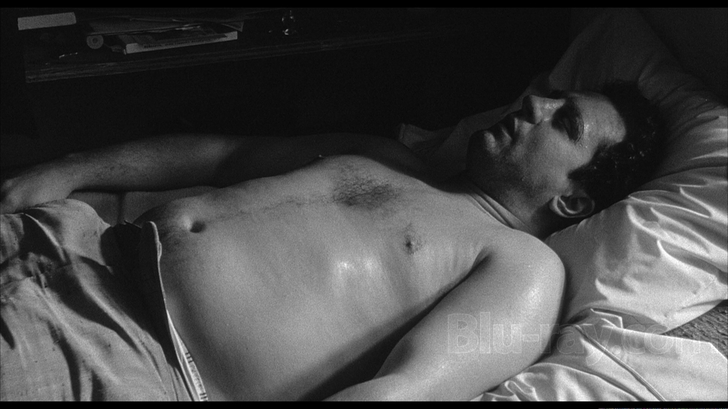
Raging Bull belongs in every serious Blu-ray collection. The technical merits of the BD-50 are solid, the 1.85:1 picture is a revelation and the film is one of the most important character studies to ever grace the silver screen. As painful as it may be to watch Robert De Niro's Oscar-winning portrayal of Jake La Motta, there are parts of his life that relate to us all. Anyone who has encountered situations where they have to take the proverbial fall and sacrifice integrity for whatever reason may find some common ground with La Motta, as uncomfortable as that sounds. He's not a sympathetic character, but the original script painted a nicer picture of him. The studio nixed it, saying that La Motta was a low-life and only a project that showed the ex-fighter to be a low-life would receive studio support. But in casting La Motta in such a negative light, Scorsese and De Niro were able to develop the unflinching intensity and raw power that is at the heart of Raging Bull. More than a biography of a man, it is a timeless masterpiece featuring two of the finest artists to work on films in the last half century. Highest recommendations for this Blu-ray edition.
Other editions
Raging Bull: Other Editions

Raging Bull
30th Anniversary Edition
1980

Raging Bull
MGM 90th Anniversary
1980

Raging Bull
35th Anniversary Edition
1980

Raging Bull 4K
1980

Raging Bull
1980
Similar titles
Similar titles you might also like

The Irishman
2019

The Fighter
2010

The Wrestler
2008

Phantom Punch
2009

Million Dollar Baby
10th Anniversary Edition
2004

Capone
2020

The Aviator
2004

J. Edgar
2011

I, Tonya
2017

Molly's Game
2017

Hands of Stone
2016

Mean Streets 4K
1973

Her Smell
2018

The Social Network
Collector's Edition
2010

Nixon
Election Year Edition
1995

Tommaso
2019

Lovelace
2013

Citizen Kane
75th Anniversary Edition
1941

The Iron Lady
2011

Sex Madness
1938